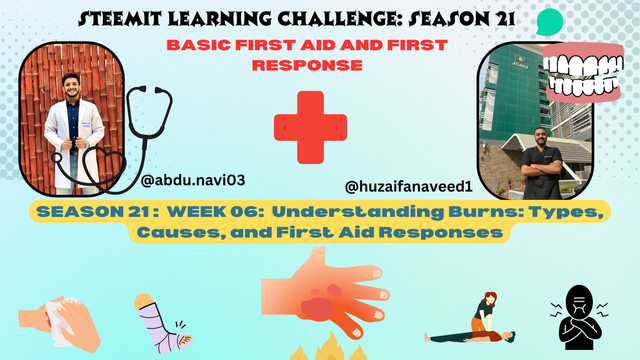SLC21/WK6: Understanding Burns: Types, Causes, and First Aid Responses [SUMMARY]

The 21st season of the Steemit Learning Challenge has come to an end, and what a ride it has been! With more than 15 teaching teams, Steemit became the first platform to offer such courses to people all over the world completely free of cost. This has undoubtedly been the Unique Selling Point. Week by week, more and more users participate in the diverse challenges offered, driven by three key incentives:
- Learning new skills
- Earning rewards
- Making new friends
For me personally, all three of these incentives have been incredibly important. However, for the 21st season, I had a different experience — that of being a teacher. It was a completely new journey that consumed most of my time. As a result, I wasn’t able to blog regularly on the topics I love or participate in other challenges. What I learned is that being a teacher in these challenges is no easy task. Let me rephrase that — being a teacher who carefully reads and fairly evaluates their students' work is truly challenging.
As for my teaching style, I’ve been a strict teacher. It’s just in my nature, perhaps due to being subjected to strict marking throughout my medical education and high school years. I suppose that’s why none of my students received a perfect 10/10 over the course of these six weeks. It’s not that no one performed brilliantly; it’s just that I believe there’s always room for improvement.
Before I move on to the summary, I’d like to mention one more point. As a Steemit user for around four years now, I have been one of the most active bloggers from my region. I’ve participated in crypto academy lessons and other courses as well. However, this Learning Challenge was my first experience as a teacher, and I have to commend the teachers who have been doing this for a while. It truly requires a lot of dedication and energy.
Now, coming to the sixth and final week, we delved into the topic of Burns. We discussed in detail the types of burns, the first aid approaches for each, and how to care for a burn victim.
We explored the different types of burns, such as first-degree, second-degree, and third-degree burns, and how our first aid response varies for each. Another critical part of the course was understanding the sources and causes of these burns. One particular aspect that generated diverse answers and perspectives was an analytical question we posed to test the students' awareness and decision-making skills.
The question was:
<You are a first responder in a rural area. Two people are injured in a house fire:Person A has a large area of third-degree burns but is conscious and calm.
Person B has second-degree burns on both legs and is in severe pain.You can only help one person immediately due to resource constraints.Whom do you prioritize, and why? Support your decision with medical and ethical reasoning.
In this post I'd explain the answer and the reasoning of this tackling with this situation:
Though Person A, who has third-degree burns, needs more attention than Person B, who has second-degree burns, we have to consider the following:
The situation
The environment
The consequences
Person A, with third-degree burns, will likely require surgery, possibly a skin graft, which cannot be performed in a rural area. Since they are calm, their condition can be managed momentarily.
On the other hand, Person B, with second-degree burns, is experiencing excruciating pain and deserves immediate medical intervention. If this is not provided, it could result in serious complications. According to the Law of Beneficence, priority should be given to the patient who can benefit the most from immediate attention. In such an environment, there isn’t much you can do for the person with third-degree burns, is there?
I hope that clarifies the situation.
Now moving towards the statistics:
Statistics |
|---|
This week, we had a total of 38 entries. I firmly believe in quality over quantity. Students often avoid courses with practical tasks, as such assignments demand more effort. However, those who choose these challenging tasks gain valuable, real-life, life-saving skills. These experiences not only enhance their knowledge but also prepare them for real-world scenarios, making their learning truly impactful.
| Total number of entries | Invalid entries | plagiarized content |
|---|---|---|
| 38 | 1 | 0 |
Out of these 38 entries *26 *users had an excellent approach, 7 users had a good approach and only 4 users had an average approach.
| 8 or above | 6 or above | below 6 |
|---|---|---|
| 26 | 7 | 4 |
Winners |
|---|
| Position | Username | Blog | Score |
|---|---|---|---|
| 1 | @sammy1109 | link | 9.6 |
| 2 | @kouba01 | link | 9.5 |
| 3 | @rossnenye | link | 9.4 |
| 4 | @bhaiaslam | link | 9.3 |
Conclusion |
|---|
Finally, the six weeks come to an end. It was a joyous ride with all of you and I hope I was able to teach you all something useful. Thank you for being such a good sport and I'd urge you to apply these first aid skills in your life.
Thank you
Regards,
Dr @huzaifanaveed1
Dr @abdu.navi03
Thank you guys so much for this Lectures, I really learnt a lot.
Gracias por incluirme esta semana y felicidades al resto de ganadores!